An in situ monitoring campaign of a hard rock pillar at great depth within a Canadian mine
Brley Fores, Nihols Vlhopoulos, Mrk S. Dieerihs, Anrew J. Hyett,Alln Punkkinen
a Department of Geological Sciences and Geological Engineering, Queen’s University, Kingston, Ontario, K7L 3N6, Canada
b Department of Civil Engineering, Royal Military College of Canada, Kingston, Ontario, K7K 7B4, Canada
c YieldPoint Inc., Kingston, Ontario, K7M 4W9, Canada
d Normet Canada Ltd., Lively, Ontario, P3Y 0B3, Canada
Abstract A recent research campaign at a Canadian nickel-copper mine involved instrumenting a hard rock sill drift pillar with an array of multi-point rod extensometers, distributed optical fibre strain sensors, and borehole pressure cells (BHPCs). The instrumentation spanned across a 15.24 m lengthwise segment of the relatively massive granitic pillar situated at a depth of 2.44 km within the mine. Between May 2016 and March 2017, the pillar’s displacement and pressure response were measured and correlated with mining activities on the same level as the pillar, including: (1) mine-by of the pillar, (2) footwall drift development, and (3) ore body stoping operations. Regarding displacements of the pillar, the extensometers provided high temporal resolution (logged hourly) and the optical fibre strain sensors provide high spatial resolution (measured every 0.65 mm along the length of each sensor). The combination of sensing techniques allowed centimetre-scale rock mass bulking near the pillar sidewalls to be distinguished from microstrain-scale fracturing towards the core of the pillar. Additionally, the influence and extent of a mine-scale schistose shear zone transecting the pillar was identified.By converting measured rock mass displacement to velocity, a process was demonstrated which allowed mining activities inducing displacements to be categorised by time-duration and cumulative displacement.In over half of the analysed mining activities, displacements were determined to prolong for over an hour, predominately resulting in submillimetre cumulative displacements, but in some cases multi-centimetre cumulative displacements were observed. This time-dependent behaviour was more pronounced within the vicinity of the plumb shear zone. Displacement measurements were also used to assess selected support member load and elongation mobilisation per mining activity. It was found that a combined static load and elongation capacity of reinforcing members was essential to maintaining excavation stability, while permitting gradual shedding of stress through controlled pillar sidewall displacements.2020 Institute of Rock and Soil Mechanics, Chinese Academy of Sciences. Production and hosting by Elsevier B.V. This is an open access article under the CC BY-NC-ND license (http://creativecommons.org/licenses/by-nc-nd/4.0/).
Keywords:Hard rock pillar Rockburst Rock mass bulking Distributed optical fibre strain sensing Extensometer In situ monitoring High stress Dynamic support
1. Introduction
Creighton mine is an active underground nickel-copper mine owned and operated by Vale in Sudbury,Ontario,Canada.The mine is situated in the south-east region of the Sudbury Igneous Complex,which was emplaced via the Sudbury Event meteorite impact and impact melt process approximately 1.85 billion years ago(Dietz, 1964; Krogh et al., 1984; Deutsch et al., 1995). Ore body mineralisation predominantly follows the contact between the granite-gabbro footwall rocks and norite hanging wall, the basal unit of the Sudbury Igneous Complex.With ore reserves discovered at depths exceeding 3 km, the current operations as part of the Creighton Deep development are actively mining at depths greater than 2.5 km.This results in in situ stress(smax3s13,wheremaxis the maximum wall stress in terms of the major,1, and minor,3, principal stresses) to unconfined compressive strength(c) ratios greater than unity (Bawden and Coulson, 1993; Malek et al., 2008; Morissette et al., 2017b) and, correspondingly, a high risk of severe rockbursting with deep burst volumes(Barton et al.,1974).In maintaining economic viability and adequate safety at the mine’s current depth, and with deeper mine development, an engineering challenge exists in the form of level layout, ore body sequencing, and ground control practice. The latter requires an understanding of the expected rock mass behaviour, failure mechanisms, and damage (Kaiser et al., 1996). In the case of Creighton mine, the presence of several late-stage faults (referred to as shear zones), which are typically schistose and biotite-rich,provides an additional complexity in determining the relationship between excavation-scale stability and the stress redistributions, and seismicity induced from bulk mining processes.In such rock mass conditions that are susceptible to rockbursting and bulking ground, Kaiser (2014) noted that the displacement demand on the ground support (a combination of dynamic and pseudo-static factors) is most relevant. However, it is difficult to numerically predict the bulking process and related elevated straining of a supported rock mass with the current capabilities of continuum, discontinuum, and hybrid numerical techniques(Kaiser, 2014; Vazaios et al., 2018).
In recent researches addressing the ground support demands at Creighton mine, Groccia et al. (2016) conducted a comprehensive monitoring study of the bulking factor at several locations on the 7910 level(2.41 km depth)of the mine.In their study,the depth of failure from the excavation periphery was measured via core photograph examination, borehole camera logging (within split sets), core logging, optical televiewer logging, and ultrasonic velocity logging. A wide range of bulking factors (1.4%e41%) were quantified and attributed to local structure and seismicity. In addition, the progressive development of failure depth was measured.However,the time intensive nature of the measurement techniques (i.e. the physical requirement to take measurements)resulted in long durations between measurements (months).Consequently, little insight was provided into the effect of daily mining processes and microseismic events on excavation stability.Multi-point rod extensometers, while providing a coarser spatial resolution than the previously discussed techniques,offer a robust and temporally advantageous alternative to measure rock mass displacements.Additionally, by installing an array of such sensors,it has been demonstrated that complex failure mechanisms within rock masses can be discerned (e.g. Spearing et al., 2013). The research highlighted in this paper presents the findings from a recent mine-by pillar experiment on the 8010 level(2.44 km depth)of Creighton mine.The project consisted of installing a combination of multi-point rod extensometers, BHPCs, and custom fibre opticbased strain sensors to measure the rock mass displacements within a sill drift pillar. Similar to the experiment conducted by Walton et al.(2016),the pillar response was measured throughout mine-by development rounds and production operations on the 8010 level. However, the research presented herein has a greater emphasis on measuring larger rock mass displacements associated with the geometric non-fit (Kaiser and Cai, 2012) during the transition from competent to fractured rock, and then fractured to broken rock. The measured pillar displacements are also used to comment upon the efficacy of rockburst-resistant ground control measures and also the impact of mine-scale structure (i.e. shear zones) on excavation stability.
2. Background of Creighton Deep
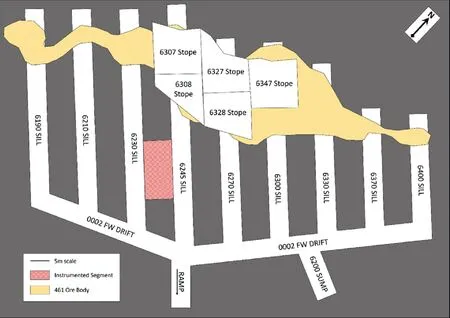
Fig. 1. Plan view of the proposed 8010 level (2.4 km depth) as of January 2016. The pillar of study was located between the 6230 and 6245 sills. The instrumented segment of the pillar is highlighted in red. Stopes taken throughout the monitoring period are also shown in the ore body.FW refers to footwall(Modified after Punkkinen et al., 2018).
The 8010 level of Creighton mine is located at an approximate depth of 2.44 km.Mining on the level primarily focuses on the 461 ore body hosted within the granitic footwall rock mass entirely(refer to Fig. 1). In general, the host granite-gabbro formation is blocky to massive with rock quality designation (RQD) (Deere,1963) of 100%, rock mass rating (RMR) (Bieniawski,1989) of 60e 75,and geological strength index(GSI)(Hoek et al.,2002)of 75e85,and has an estimated unconfined intact compressive strength of 240 MPa and a Young’s modulus of 60 GPa.The in situ stress field at this depth in the mine is provided in Table 1.Considering the high in situ stress to rock mass strength ratio, the expected excavation behaviour is categorised as stress-driven brittle failure of the intact rock in the form of heavy rockbursting (Barton et al.,1974; Kaiser et al., 2000).
Rockbursting, according Kaiser et al. (1996), is defined as“damage to an excavation that occurs in a sudden and violent manner and is associated with a mining-induced seismic event”. This failure type can be further classified into various mechanisms, including strainbursting, face/pillar-bursting, and shear/fault-slip (Ortlepp,1997; Kaiser and Cai, 2012). There is also a distinction between rockbursts that are directly mining-induced (coincident with the seismic source)and those that are dynamically triggered by mining(remote from the seismic source)(Hudyma and Heal,2007;Kaiser,2018). At Creighton mine, seismicity has been identified since 1934 at depths of 0.7 km. However, it is the more recent developments at depths greater than 2 km that has associated rockbursting and related seismicity with day-to-day mining activities(Malek et al.,2008).This has promoted the evolution of bulk mining techniques and ground control practice to best avoid rockbursts(Cai and Champaigne, 2009), but when necessary, accommodate the high levels of mining induced stress. Regarding the primary focus of avoiding rockbursts, development and production activities are distanced from highly stressed rock mass regions through a combination of destressing techniques(e.g.O’Donnell,1999)during sill development and modifications to traditional vertical retreat mining procedures. A slot-and-slash method is currently used to mine steeply dipping ore bodies. This is a pillarless open stopingtechnique performed in a top-down and centre-out (or V-shaped)sequence in order to concentrate stress into the abutments(rather than leave stressed pillars within the ore body).In addition,the top sills are developed subsequently beneath or within the previously mined and backfilled stopes of the level above (Yao et al., 2014).These measures reduce the direct exposure of equipment and personnel to rockbursts, but do not eliminate the occurrence of rockbursts within the mine. Accordingly, rockburst compatible ground support systems(that have dynamic capacity)are required to improve the stability and reinforce the rock mass (Brady and Brown, 2006), retain broken rock blocks and tie back retaining elements, and contain dynamic loads (Kaiser et al.,1996).

Table 1Estimated in situ stress field on the 8010 level of the Creighton mine (from measurements taken by Bawden and Coulson,1993;Malek et al.,2008;Morissette et al.,2017b).
The support system employed on the 8010 level evolved following rockbursts experienced while mining the 461 ore body on upper levels(7680 level at depth of 2.34 km,to the 7910 level at depth of 2.41 km). From experiencing an increased frequency of rockburst events with increased depth of mining, a priority was placed on developing a first-pass (and single-pass) dynamic support system that would provide immediate stability to the excavation and also mitigate exposure to a potential rockburst event.Much of the evolution in terms of reinforcement of the rock mass at the mine involved the progression from stiff support tendons,which are prone to localised loading and brittle post-peak behaviour(e.g.fully grouted rebar and mechanically anchored rockbolts),to support tendons that can distribute load and have a ductile postpeak behaviour (e.g. friction coupled and dynamic rock bolts).Localised loading and undesired angular orientations of the support tendon at the excavation periphery is avoided by using a dome face plate that is coupled to the support tendon with spherical washers.Additionally,a single#0/0-gauge 300 mm mesh square is placed under the face plate to distribute load more efficiently from the face plate to the screen or shotcrete surrounding the excavation(Yao et al., 2014). Ground control measures have also been optimised through the qualitative and quantitative assessment of support demands at various locations throughout the mine (e.g.Yao et al., 2009). This has led to recommendations of locationspecific, as well as modifiable, support systems. For example, the support demand required in the top sills developed underneath or within the previously backfilled stopes will vary from that of drift and intersection development in the granitic footwall rock mass.However, the ground control challenge still exists in determining how the rock mass displaces with continued mining activity over time,and correspondingly,how the load and elongation capacities of the support system are consumed. This brings forth concepts of excavation vulnerability or susceptibility to rockbursts and other stability issues (e.g. Heal et al., 2006; Heal, 2010; Kaiser and Cai,2013; Duan, 2016).
In the systematic design/selection of ground support, each potential failure mode must be considered (i.e. the support system must be designed to withstand a given depth of failure and corresponding static and/or dynamic loads within a given safety margin depending on the in situ stress and rock mass conditions). If designed correctly, the support system when first installed can be considered to have a relatively high safety margin or low probability of failure. However, with increased mining activities (i.e.increased extraction ratios and mining induced stresses), the load and elongation capacities of the support system will be mobilised.With continued loading, a ground support system that is brought up to or near a state of unstable equilibrium will be highly susceptible to failure/collapse through a coincident or remote seismic event. In this sense, it is critical to understand the mechanisms by which various support members are mobilised and the interaction between static and dynamic support member capacities.
Stress-driven rock mass fracturing and bulking have the potential to result in localised displacement demands at the upper limit and approaching the capacity of a particular support system.Regarding rockbursts, stiff support may inadvertently increase an excavation’s vulnerability to strainbursting by preventing a gradual notch formation to develop. Contrarily, if the support system does not provide sufficient radial resistance, the rock mass may lose its ability to self-support(e.g.through ravelling of the stress-fractured arch). Kaiser (2018) remarked that a well-reinforced rock mass,even with the presence of stress fractures,can provide significantly more confinement than a support system alone. In such a reinforced rock mass, it is important to consider that the individual members of a multi-component support system will undertake unique loading characteristics. It cannot be assumed that each member will equally load or expend its capacity. This provides an inherent complexity in quantifying the rock mass response and stability of a reinforced rock mass.Directly measuring the load and/or displacement response of individual members of a multicomponent support system would require significant sensing resources,and may not capture the excavation response in its entirety(e.g. if the depth of failure extends past the given support members). Accordingly, there is a sensing resource advantage to measuring the displacement response of a reinforced rock mass(e.g. with multi-point extensometers) and inferring the load/displacement response of the support system, and its constituent members (e.g. through loadedisplacement response curves), as well as the full excavation response to mining induced stresses and dynamic disturbances within the mine.This has been performed at Creighton mine within the framework of understanding contributing factors to excavation vulnerability.
3. Mine-by monitoring experiment
3.1. Monitoring location and objectives
The location of the mine-by monitoring project was along a sill drift pillar on the 8010 level (approximate mine level depth of 2.44 km)at Creighton mine.Referring to Fig.1,the pillar was hosted within the granite-gabbro footwall rock formation situated between the 6245 and 6230 sills.Sill geometry on the level consisted of a 4.88 m wide by 4.88 m high excavation with vertical sidewalls and rounded shoulders at approximately 3.65 m from the floor.Pillars between adjacent sills had a specified width of 7.31 m, and accordingly, a width to height ratio of 1.5. Ground control for sill excavations of the 8010 level included, but was not limited to:2.44 m long, 22 mm diameter D-bolts (Li, 2010) in the crown extending down to the upper walls (3.05 m from the floor), 2 m long,46 mm diameter welded ring friction sets in the sidewalls,#4-gauge galvanised welded steel-wire mesh along the sidewalls(and back when required),and a layer shotcrete layer along the sidewalls that covers the steel-wire mesh and friction sets (Punkkinen and Yao, 2007; Yao et al., 2014; Punkkinen et al., 2018). Single #0/0-gauge 300 mm mesh squares were installed under 150 mm square washer plates with the D-bolts and friction sets to prevent localised failure of the#4-gauge steel mesh and help hold the steel mesh prior to shotcrete. When necessary, an additional #4-gauge welded steel-wire mesh is installed over top of the shotcrete based on observations that installing the steel mesh within shotcrete significantly reduces the elongation capacity of steel mesh(i.e.through localised failure)and its ability to restrain loose blocks at the excavation (Punkkinen and Mamidi, 2010). In this manner,the primary role of the external steel mesh is to contain fractured rock and spalled shotcrete at the periphery.
Rock mass displacement and pressure sensors were installed along an approximately 15.24 m lengthwise segment of the pillar on 4 May 2016. This instrumented pillar segment ranged from 7.62 m from the pillar nose at the 0002 footwall drift and 12.5 m from the 461 ore body (Fig. 1). A combination of multi-point rod extensometers,BHPCs,and custom fibre optic strain sensors(FOSs)were installed within the 6245 sill on 4 May 2016 and extended across the entire width of the pillar(Fig.2).All instrumentation was installed within freshly-drilled horizontal boreholes at 2.44 m from the floor and cement toe-grouted until the borehole was filled.Borehole inclination was measured to be approximately 55for all boreholes except for extensometers EXTO_08 and EXTO_09,which had measured inclinations of 105.At the time of sensor installation,the 6230 sill had yet to be developed.Excavation round lengths and dates for the development of this sill are presented in Fig.2.The toe-end of the sensors was situated within proximity to the sidewall of the 6230 sill. This necessitated an alteration to the current precondition or “destressing” practice employed at Creighton mine, which specifies the charging of preconditioning holes drilled ahead of the future face as well as in the upper and lower walls. Accordingly, the requirement for sidewall destressing was removed for the 6230 sill to best protect the toe-end of the sensors. As part of this procedural change, re-entry into the 6230 sill was restricted until it could be verified that all adverse seismic activity had decayed to background levels following an excavation advance. Face destressing protocols were not altered.
On 28 February 2017, four additional FOSs were installed within the 6230 sill (Fig.3). These sensors were installed prior to mining of the 6307 stope at the end of the pillar(Fig.1).Referring to the Figs. 2 and 3, two additional comments about the level layout and geologic structure should be noted. Unlike the proposed 8010 level layout(Fig.1),the 0002 footwall drift that is west to the 6245 sill was shifted approximately 15.5 m north-west(towards the ore body) along the 6230 sill. This was implemented due to encountered stability issues when mining subparallel with the northeast-southwest orientation of a steeply dipping geological feature.
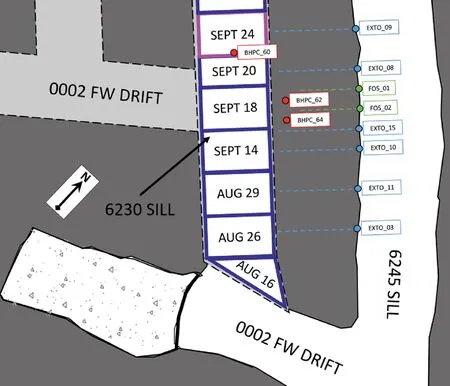
Fig. 2. Plan view displaying the installation locations of six digital extensometers(blue), three BHPCs (red), and two FOSs (green) as of 4 May 2016. The dates and advance lengths of mine-by excavation rounds along the 6230 sill are also displayed.FW refers to footwall (Modified after Punkkinen et al., 2018).
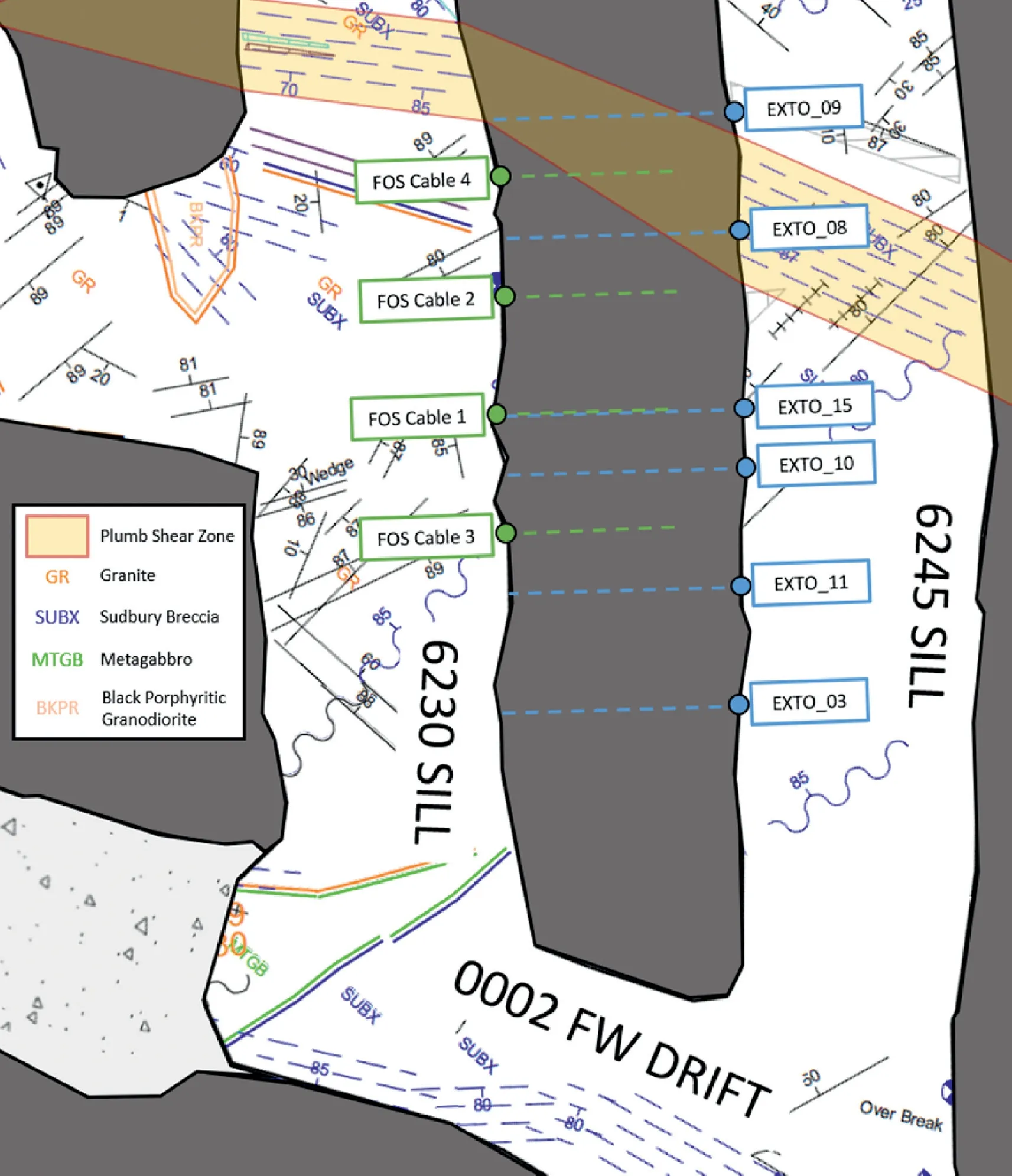
Fig. 3. Geological plan view of the 6245 sill, 6230 sill, and 0002 footwall (FW) drift within proximity of the instrumented pillar segment as of 28 February 2017. The locations of FOSs instrumented cable bolts are displayed with reference to the digital extensometers installed approximately nine months prior (Modified after Punkkinen et al., 2018).
Twelve persistent fault zones containing schistose material(locally termed shear zones)have been identified in the Creighton Deep development (Coulson, 1997; Morissette et al., 2017a). The most seismically active of these faults is the plumb shear zone(PSZ), receiving its name due to its strong association with identifying the presence, shape, and distribution of the plumb ore body(i.e.the 461 ore body)(Seidler,2008).The PSZ is characterised by steeply dipping schistosity containing sub-vertical biotite mineral foliation (mostly healed) and varies in thickness from centimetres to several metres (Malek et al., 2008). High magnitude seismic events and extensive excavation damage (i.e. >100 t of displaced rock mass) are often attributed to lock-up/release and fault slip mechanisms along shear zones. However, it has been debated that the shear zones only indirectly promote seismicity by governing stress realignment in the footwall rock mass (Snelling et al., 2013). Nevertheless, a recent back analysis of seismicity experienced at Creighton mine from 2000 to 2013 determined that the majority (>75%) of high damage rockbursts (i.e. >10 t of displaced rock mass)occurred within 15 m of the nearest shear zone,with the PSZ being accountable for the highest number of events(Morissette et al., 2017a). Referring to Fig. 3, the PSZ has been mapped to transect the pillar of study in the vicinity of extensometers EXTO_08 and EXTO_09.
Within the context of monitoring the given pillar at Creighton mine, three primary objectives were identified:
(1) Measure the supported rock mass displacement response to mining activities on the 8010 level;
(2) Investigate the impact of transecting mine-scale structure(in specific, the PSZ) on excavation stability and induced seismicity; and
(3) Determine the efficacy of ground control and destressing measures on the 8010 level (in specific, the effect of eliminating wall preconditioning during the 6230 sill development).
Further details on the installed instrumentation and the 8010 level mining operations that were conducted during the monitoring programme are provided in the following subsections.
3.2. Sensing techniques
Three sensing technologies were installed to monitor the pillar response during mine-by development and 8010 level production operations: (1) multi-point rod extensometers, (2) rock mass displacement and support strain measuring FOSs, and (3)vibrating-wire BHPCs. A general overview of these sensing technologies and comments on their installations in the given pillar at Creighton mine is presented within the following subsections.
3.2.1. Multi-point rod extensometers
An array of six multi-point rod extensometers (YieldPoint Inc,2017) was installed within the 6245 sill on 4 May 2016. The head of each extensometer housed six variable induction displacement coils that allowed coaxial displacement to be measured at six specified locations along the full length of the extensometer body(totalling 36 measurement locations). The six measurement locations along each extensometer were distinguished by serrated aluminium anchors that anchored within the cement grouted borehole. Each measurement location (or anchor point) had a 150 mm stroke (with 25 mm maximum contraction and 125 mm maximum elongation selected for this experiment), 0.01 mm measurement resolution,and better than 0.5%full stroke accuracy.The anchor point arrangement for the extensometers installed into the pillar is presented in Fig. 4. Extensometer boreholes with an approximate total length of 6.5 m were drilled. This allowed the head anchor (closest to the 6245 sill) to be recessed 0.4e0.5 m within the pillar, which also situated the 6th anchor at a similar depth from the 6230 sill when factoring in overbreak.Recessing the extensometer head was considered a necessity for protecting the head assembly at later stages in the mine development when the 6245 sill would be used for mucking.A 1-h logging interval was set for each extensometer to prolong the battery life of 4-channel loggers (YieldPoint Inc, 2014), as the instrumentation was not accessible during certain stages of the 8010 level progression.
3.2.2. Distributed optical strain sensing (DOS)
Advancements in data logging and transmission techniques for current multi-point rod extensometers allow for real-time, hightemporal-resolution monitoring of rock mass displacements.However, the limited number of practical sensors along a single extensometer inherently limits the spatial resolution of measurements. This is extremely disadvantageous for monitoring brittle rock mass behaviour as an array of discrete measurement points or zones will be prone to misinterpretation and possibly omission of localised displacements and fracturing.One interesting alternative to measuring rock mass displacements is the consideration of DOS.There are currently several commercially available DOS technologies which use an optical time domain reflectometry/analysis, optical frequency domain reflectometry,or optical correlation domain reflectometry/analysis technique to interrogate strain along the length of a low-cost silica optical fibre. Of the listed techniques, a Rayleigh backscatter-based optical frequency domain reflectometer offers a solution to measure strain at a spatial resolution of 0.65 mm,providing an unprecedented opportunity to monitor the pillar response at Creighton mine. However, transferring this technology to the mining environment is a non-trivial development(Inaudi et al.,1996;Heasley et al.,1997).A challenge exists in protecting the 250 mm diameter optical fibre from localised failure,while simultaneously not over-dampening the displacement transfer between the FOS and brittle rock mass response (i.e.negating the spatial resolution benefit of using DOS).
A monitored mine-by experiment focused on a sill drift pillar on the 7910 level at Creighton mine (the production level immediatelyd30.5 mdabove the 8010 level) measured displacements that were less than 15 mm over an eight-month monitoring period.This included mine-by development and stoping at the end of the pillar (Walton et al., 2016). The highest magnitude displacements (>10 mm) were measured within 1 m from the pillar sidewalls. Lesser magnitude displacements were measured within proximity to the pillar core (<5 mm measured). The larger magnitude displacements (10e25 mm of elongation) are well within the range of the multi-point rod extensometers selected for this experiment. Therefore, the design of the FOS was focused on measuring submillimetre displacements, especially towards the core of the pillar.Two FOS configurations were initially conceived:(1) a coaxial sensing configuration and (2) a shape sensing configuration (Forbes et al., 2017), with both configurations suspending an optical fibre along a core assembly (Fig. 5). The core assembly was then housed within a 25.4 mm outer diameter flexible plastic conduit and cast within a urethane rubber(Fig. 6).The FOSs were designed to connect with a 1.75 m long PVC conduit to recess the sensor towards the core of the pillar and avoid larger displacements at the pillar wall as measured by Walton et al.(2016). Both sensor configurations were calibrated and limit tested up to 20 mm (i.e. four times the anticipated displacement magnitude). However, concerns that localised, sub-vertical shear displacements(which would have not been measured/identified by the extensometers installed during the 7910 level pillar study)would potentially damage the sensors warranted the installation of a more heavily protected FOS. This was approached by instrumenting a 7-strand steel cable bolt(Forbes et al.,2018).The sensor design consists of replacing the central strand of the cable bolt with an instrumented stainless steel tube. This stainless tube was instrumented with a single optical fibre sensor that was centred and encapsulated using a two-part epoxy resin(Fig.7).Four 4.75 m long optical fibre instrumented cable bolts were installed into horizontal boreholes (maximum inclination measured to be 4.52.5) from the 6230 sill and cement grouted. This length situates the sensors past the centre of the pillar,but not fully to the 6245 sill (Fig. 3).
3.2.3. Borehole pressure cells
In addition to the multi-point rod extensometers and FOS,three BHPCs (Geokon Inc, 2019) were installed to compare the induced rock mass displacements and the stress change within the pillar.

Fig. 4. Multi-point borehole extensometer anchor locations referenced to the head anchor (closest to the 6245 sill).
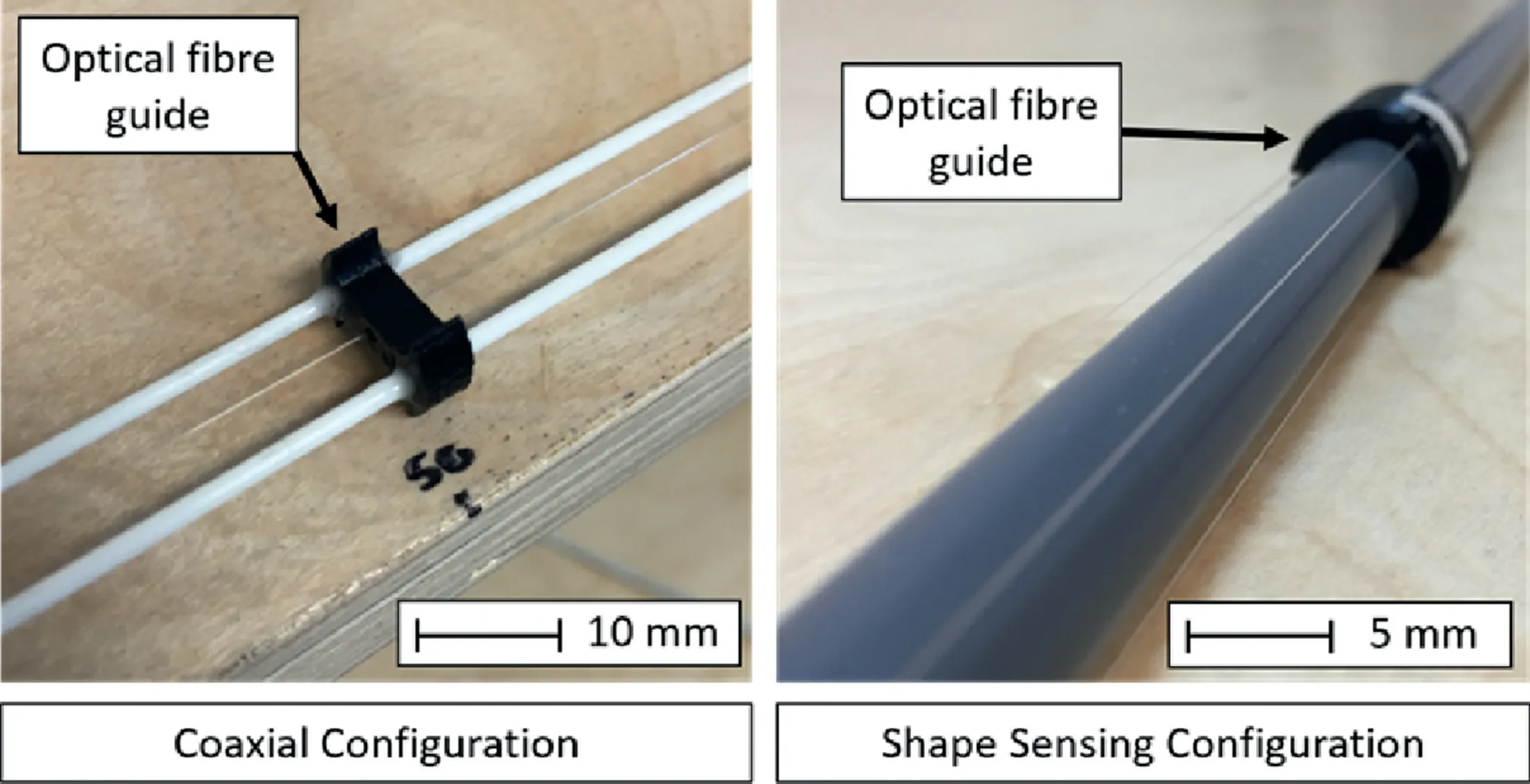
Fig.5. Core assembly of the optical fibre displacement sensors.Coaxial sensor(left):Tensioning of the optical fibre to be situated along the centroid of the assembly.Shape sensor(right): Tensioning of the optical fibre to be situated along three lengths of the assembly in a delta (i.e.120) configuration.

Fig. 6. Example optical fibre sensor. The 25.4 mm outer diameter flexible plastic conduit houses the optical fibre core assembly which has been centred and fully cast using an urethan rubber compound.
A flatjack type pressure cell was selected for the experiment,which is predominately sensitive to stress in one plane (Sellers,1970). Accordingly, BHPC_62 and BHPC_64 (Fig. 2) were installed with flatjacks at perpendicular orientations: horizontally orientated to measure stress changes in the vertical plane and vertically orientated to measure stress changes along the pillar axis,respectively. These BHPCs were situated approximately 1 m from the 6230 sill. BHPC_60 was installed into a 9.75 m long borehole from the 6245 sill to situate the flatjack pressure cell approximately in the middle span of the 6230 sill.This BHPC was installed with its flatjack vertically orientated to measure stress changes in plane with 6230 development rounds.Ideally,an additional BHPC would have been installed with the flatjack parallel to the axis of the pillar;however, difficulties were encountered in maintaining borehole integrity from the nose of the pillar.
3.3. Monitoring programme
The monitoring programme of the 8010 level instrumented pillar ran from 19 May 2016 to 30 March 2017. During this period,the 6230 sill was developed past the instrumented section of the pillar,the footwall drift west of the 6245 sill was repositioned and developed along the 6230 sill,and level-located stoping operations were conducted on the 6327,6320,6347 and 6307 stopes(refer to Figs. 1e3). Information regarding the size, duration, and induced seismicity from development and production rounds were compiled to compare with the measured rock mass displacements and stress changes. A summary of mining operations during this period is presented in Table 2, which has been amalgamated from Punkkinen et al.(2018).Multi-point rod extensometers and BHPCs were logged continuously at 1 h intervals using battery powered logging devices.A long-term battery powered logging solution was not available for the DOS technology at the time of this experiment.Additionally, the unavailability of reliable power during the 8010 level development necessitated physical measurements to be taken with the optical fibre based sensors.In this regard,the multi-point rod extensometers provided high temporal resolution measurements of rock mass displacements within the pillar while the FOS(being used as an inspection tool)provided high spatial resolution measurements.

Fig. 7. Optical fibre instrumented plain strand cable bolt construction using 15.24 mm nominal diameter steel strand (Forbes et al., 2018).
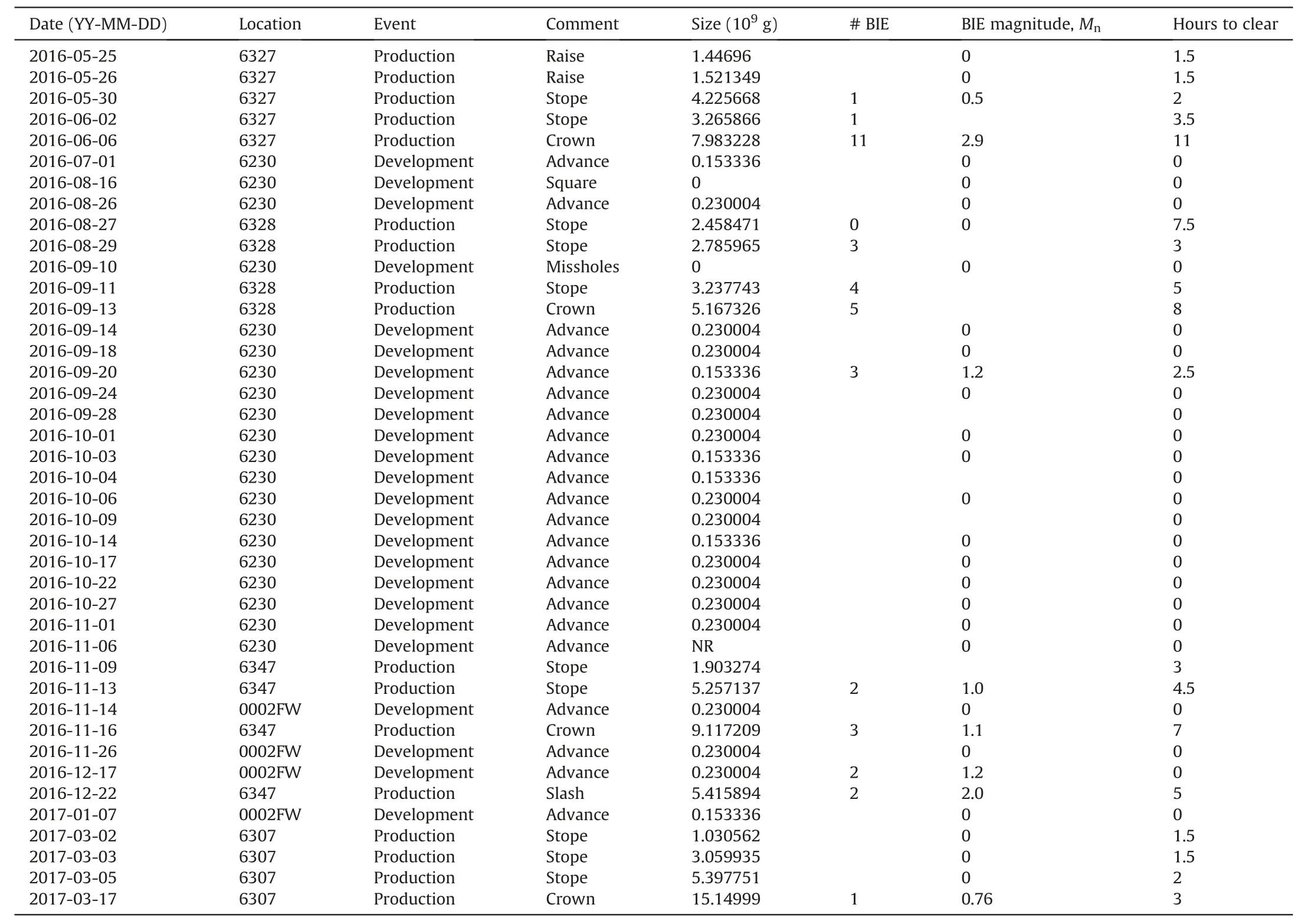
Table 2Summary of 8010 level mining operations.
4. Monitoring results
The following section presents an overview of the displacement,strain, and pressure response measured across the sill drift pillar.Refer to Figs. 2 and 3 for the positioning of sensors.
4.1. Multi-point rod extensometer results
Approximately 7500 measurements were logged for each anchor location of the six installed multi-point extensometers.These measurements were continuously updated into time series plots of the rock mass displacement. Fig. 8 displays the displacement measurements for each extensometer with selected dates and events annotated.It should be noted that the third anchor location was taken as the reference position for displacement measurements. This anchor for each extensometer was located at the approximate middle span of the pillar. Therefore, each displacement-time series plot presents the rock mass displacements approximately referenced from the pillar centre, where positive displacements are in the direction of the 6230 sill and negative displacements are in the direction of the 6245 sill.
As of 21 September 2016, specific anchor locations were either damaged or had their displacement range exceeded(this has been illustrated with a transition from a solid to dashed line in the plots of Fig.8).A clear example of this in the measurement data is shown for EXTO_09 within the period of 20e24 September 2016. During this period, the 6230 sill was advanced past EXTO_09 (the extensometer closest to the ore body).Following the 6230 sill advance on 20 September 2016,the displacement of anchor 6(i.e.closest to the 6230 sill) displaces significantly over a 1-h period (i.e. the logging rate) and then continues to displace up to 24 September 2016.However, the induced displacement accompanying the advance round on 24 September 2016 exceeded the displacement range of anchor 6. After noticing this in the measurement data, an investigation in the newly excavated 6230 sill found anchor 6 from extensometer EXTO_09 visible(extending out)near the shoulder of the excavation.A summary of encountered measurement issues or limitations for all extensometers is presented in Table 3. As a majority of these issues were within several months of the 6230 development, it was selected to present the displacement measurements of the entire pillar width only up to 21 December 2016.

Fig.8. Measured anchor displacement profiles referenced to the third anchor position(approximately the centre position of the pillar)from 19 May 2016 to 21 December 2016 for each digital extensometer.Positive displacements are in the direction of the 6230 sill while negative displacements are in the direction of the 6245 sill.A dashed line displacement profile indicates an issue or limitation with the measured displacements (refer to Table 3) (Modified after Punkkinen et al., 2018).
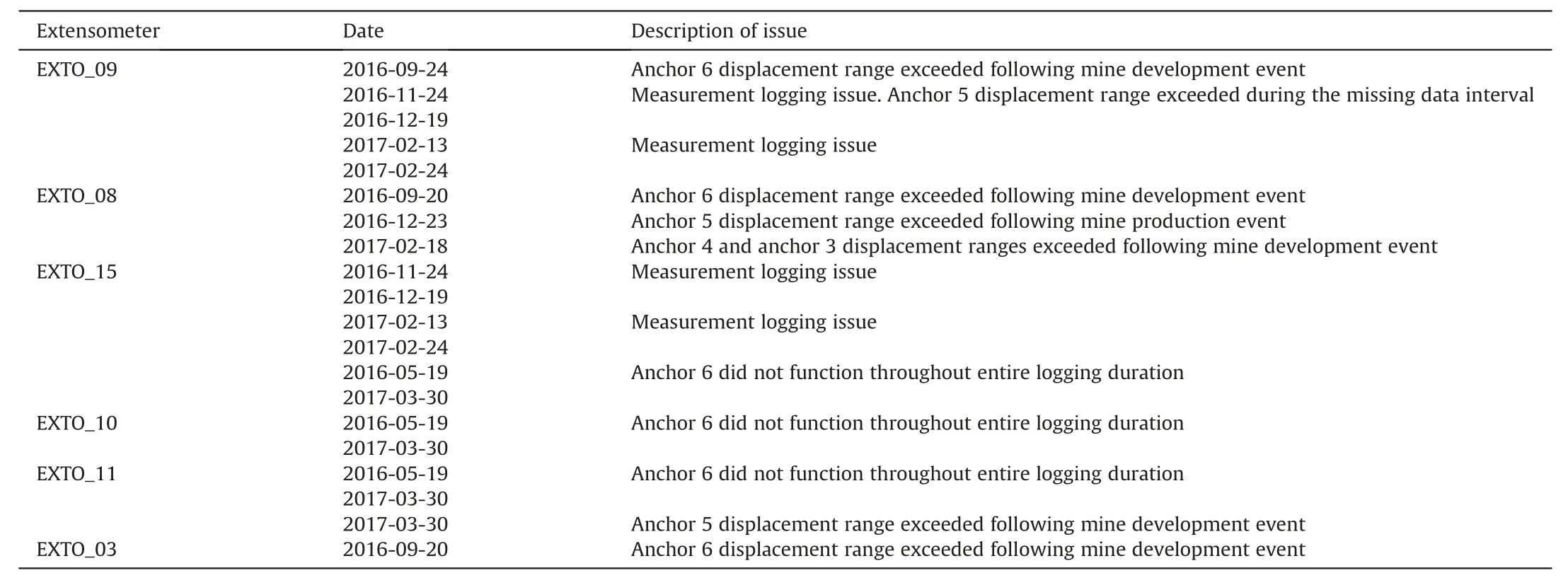
Table 3Identified issues and limitations with extensometer anchor displacement measurements.
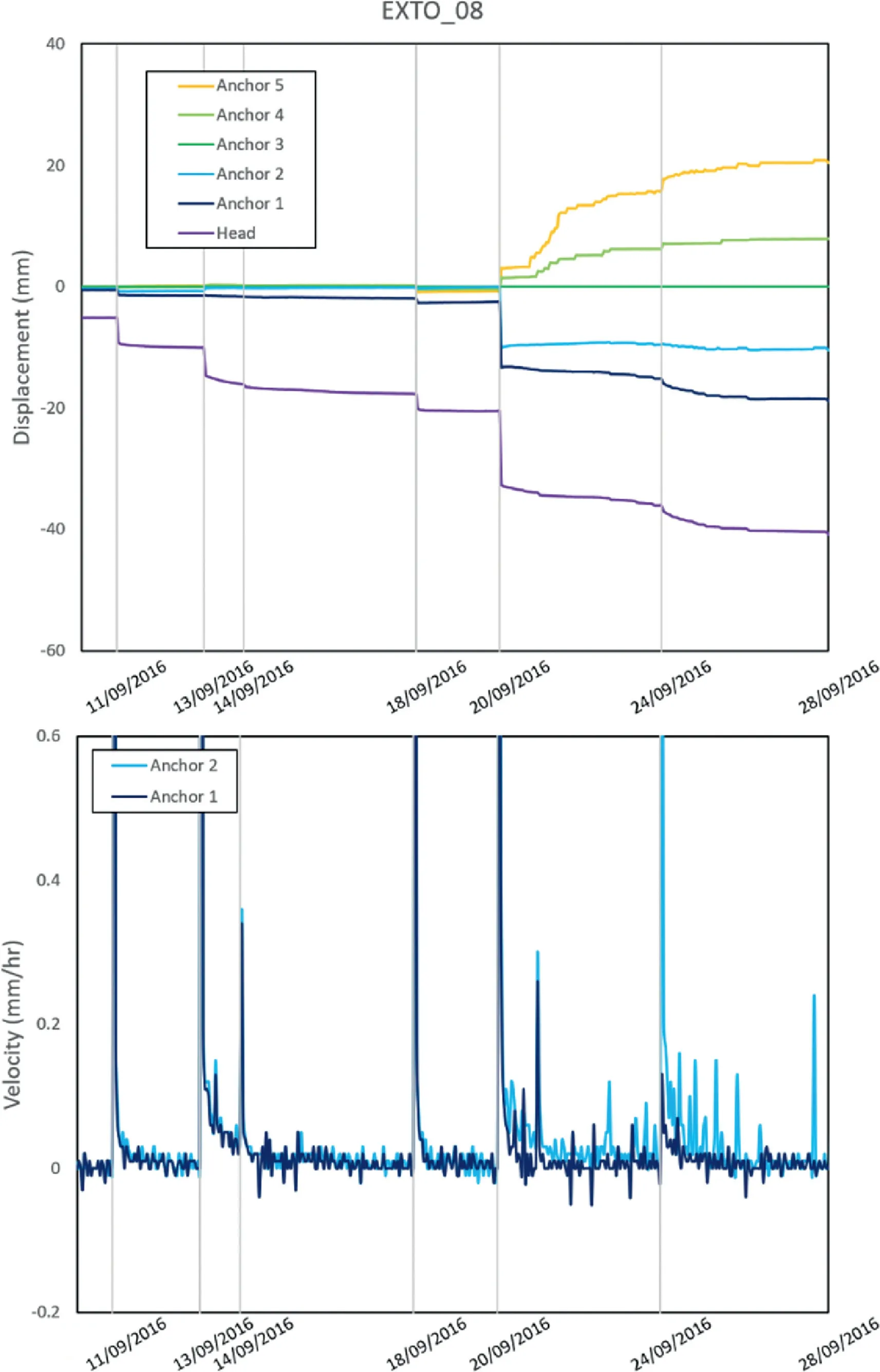
Fig.9. Displacement-time series profiles(top)and corresponding velocity-time series profiles (bottom) for selected anchor positions of extensometer EXTO_08 from 10 September 2016 to 28 September 2016.
In general, the most significant displacements were measured over the period of 26 August 2016 to 1 October 2016 by the head,5,and 6 anchor positions (nearest to the pillar sidewalls). This corresponds with the substantial loss of confinement to the instrumented pillar (especially at the sidewalls) as the 6230 sill was advanced past each extensometer. Mining-induced stress changes from level production blasts (i.e. stoping) and footwall drift development along the 6230 sill (e.g. 26 November 2016) also induce noteworthy displacement measurements. An examination of the displacement-time series plots reveals a time-dependent nature to the measured rock mass displacements. Following selected mining activities(Table 2),there is an immediate increase in the magnitude of measured displacement over the first logging interval (i.e.1 h). Displacements then continue to accumulate at a decaying rate until a new position of stability is reached.Similar to cumulative seismicity and seismicity rate analysis for re-entry protocols (e.g. Vallejos and McKinnon, 2011), the time-dependent displacement behaviour can be analysed by conducting a 1-h linear regression of the measured displacements to obtain velocity-time series profiles for each extensometer anchor position(Fig.9).The velocity profiles can then be used to quantify the timeduration of mining activity induced displacements by determining when the velocity returns to the noise floor or the background velocity measurement (approximately0.01 mm/h) (Fig. 10). To determine the time-duration from the velocity-time series profiles,a Hampel filter was employed to filter out possible low velocity occurrences (i.e. below the noise floor) that were not indicative of displacement stabilisation for a given anchor position. It was also necessary to analyse the absolute velocity profiles in order to capture instances where bulking or extension (positive displacement)was followed by contraction(negative displacement),or vice versa. The time-durations of anchor displacement following a mining activity for all extensometer anchor positions are presented in Fig.11(left plot).This plot only displays instances where anchor displacement was induced via a mining activity.The shortest timeduration that could be determined was 1 h,as per the logging rate.

Fig. 10. Visual explanation of event time-duration determination from an example velocity-time series profile. IOLV refers to an interval of low velocity which is not indicative of displacement stabilisation.
From the time-duration of mining activity induced anchor displacement,two other measures of the rock mass response were quantified:
(1) The immediate anchor displacement, which refers to the displacement measured in the first hour (or one logging interval) after a mining activity was conducted; and
(2) The cumulative anchor displacement, which refers to the measured displacement over the determined time-duration.
The difference between the cumulative displacement and the immediate displacement has been considered as the extended displacement.
A comparison of the immediate and extended anchor displacements for all mining activities which induced displacement are presented in Fig.11 (right plot). This categorises a total of 583 instances of mining activity induced anchor displacement across all extensometers. Among 583 instances, 488 instances (83.7%) are binned between 0 mm and 1 mm (i.e. sub-millimeter displacement). Furthermore, 362 instances (62.1%) are within the range of 0 mm and 0.1 mm. Referring to the timeeduration plot, 238 instances(40.4%)are categorised as single hour events.An increased logging rate would most likely have distinguished more induced displacement events and would have provided a more accurate event time-duration to compare against seismic measurement arrays at the mine; however, the 1-h logging rate was necessary to prolong battery life.Nevertheless,the extensometer data set clearly distinguishes that in over half of the instances where displacement was induced via a mining activity on the 8010 level,displacements within the granitic pillar accumulated for multiple hours post activity. In some instances, the extended displacement was substantially more than the immediate displacement. To further examine this time-dependent response across the pillar, the extensometer data were categorised by anchor position(or position within the pillar). A comparison of the time-duration and the cumulative displacements induced via mining activities is presented in Fig.12 for the six anchor positions.
In general, an increased number of multi-hour time-durations were measured towards the pillar sidewalls (i.e. anchor positions:Head,1, 5,and 6).The magnitude of induced anchor displacement was also larger towards the pillar sidewalls. These observations were anticipated considering the variability of confining stresses spanning the pillar (lowest at the walls) and is expected to have been even more pronounced if the 6th anchor position for all extensometers had continued to operate for all of the investigated mining activities. However, there were an unexpected number of large displacements and multi-hour time-durations induced at the anchor positions nearest to the pillar core (i.e. anchor positions: 2 and 4).Although these events were found to primarily correspond with sub-millimetre cumulative displacements, in the several instances, the cumulative displacement of anchor positions 2 and 4 exceeded 1 mm. A further inspection of these irregularities revealed that all cumulative displacements over 0.5 mm for anchor positions 2 and 4 were attributed to EXTO_08. Referring to Fig. 8,the symmetry of the displacement-time series profile of EXTO_08 for anchors 2 and 4 suggests that displacement extended across the entire pillar in the region surrounding this extensometer. Therefore, to more accurately understand the pillar response in this region, the displacement measured at each anchor position was converted to strain between adjacent anchor positions (removing the reference position necessity of displacement measurement data).Fig.13 presents a comparison between the strain-time series profiles for EXTO_08 and EXTO_11 for a period of the 6230 mine-by(10e28 September 2016).The strain-time series profile of EXTO_11 is characteristic to the response of the other extensometers,in that little strain is measured within the vicinity of the pillar core (i.e.Anchors 2:3 and Anchors 3:4). However, the strain-time series profile of EXTO_08 is unique, clearly indicating significant strain,and therefore displacement,across the entire span of the pillar.This inconsistency is attributed to the presence of the PSZ, which transects the pillar in proximity to EXTO_08 (and also the toe-end of EXTO_09), as further investigated in the discussion section of this article.
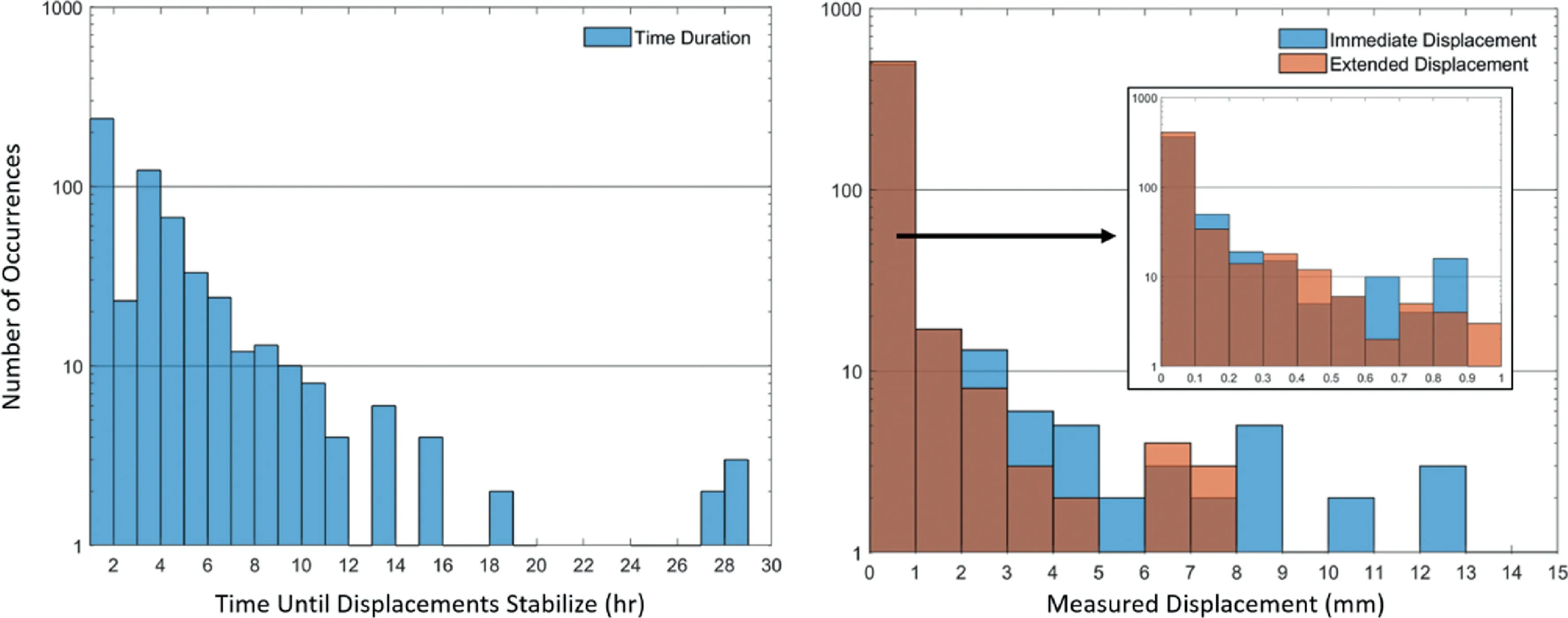
Fig.11. Histogram plots displaying the frequency distribution(log-scale)of mining activity induced extensometer anchor displacements(for all extensometers).Left plot:Time until anchor displacement stabilises following a mining activity. Right plot: Comparison between immediate and extended anchor displacement. An increased bin-width resolution for displacements between 0 mm and 1 mm is presented within the right plot.Note:There are three events not shown in the left plot(for visualisation purposes):individual instances with time durations of 40 h, 49 h, and 57 h.
4.2. DOS results
Unlike the extensometer measurements, the FOSs required a constant power source in order to record strain measurements using the selected DOS technology. During the early stages of the monitoring programme, while the 8010 level was still in development,power was only available for short intervals. This prevented the configuration of a continuous logging routine for DOS measurements. Accordingly, manual measurements were required for all of the DOS measurements.
The initial DOS measurements are associated with FOS_01 and FOS_02. A baseline reading was taken for these sensors postgrouting on 20 May 2016. Three other measurements were taken, albeit with several issues being encountered, as summarised in Table 4. Fig. 14 displays the strain profiles measured for FOS_01 and FOS_02 as well as the displacement profiles that have been obtained by integrating the strain profiles from the head of the sensor for FOS_01 (due to the broken sensor length) and the toe of the sensor for FOS_02 (i.e. displacements from the core of the pillar). The FOS displacement profiles compare well with the displacement profiles measured by the extensometers that are immediately adjacent to each FOS. Both FOS_01 and FOS_02 measure similar displacement magnitudes as the extensometers;however, the strain profiles obtained with DOS provide substantially more insight into the response of the rock mass across the pillar. Referring to the plot for FOS_02, the sub-millimetre magnitude displacement measured across the pillar is observed to be the result of numerous,localised dilational and contractional strain events, indicating fracturing to be the dominant mode of yield across the pillar. This behaviour is consistent with previous findings that detail the spalling limit to dictate the lower bound damage initiation threshold across of the pillar,even at its highest confinement near the core(Diederichs,2003;Walton et al.,2016).This behaviour is also apparent for the strain profile of FOS_01 measured at a later date (and progression of the mine-by), for which an order of magnitude greater level of strain and displacement is measured. It is unfortunate that a measurement could not be obtained for either FOS on 16 September 2016,as this date corresponded to a position of the 6230 excavation face prior to mine-by of the FOSs. Referring to Fig. 8, the three subsequent 6230 advances induced substantial displacements across the pillar,much past those anticipated from Walton et al.(2016).These displacement magnitudes exceeded the sensor design range and locally failed both sensors.
As a consequence of the unanticipated high magnitude rock mass displacements, it was prudent to drastically increase the durability of the DOS technique for a secondary monitoring campaign, even though this would dampen the transfer of rock mass displacements. This was approached by developing a technique that coupled the optical fibre sensor with a 7-strand steel cable bolt (Forbes et al., 2018). Four FOS cables were installed and grouted from the 6230 sill on 28 February 2017. The installation date for these sensors was selected in order to measure the pillar’s response to mining the 6307 stope. The measured strain profiles from the un-plated, plain-strand instrumented cable bolts: FOS Cable 1 and FOS Cable 4,are presented in Fig.15 for the period of 1e 6 March 2017 (corresponding to three mining operations of the 6307 stope, Table 2). It is significant to note that the strain profilefor each FOS cable corresponds to the strain along the instrumented central strand.This will reflect a higher strain(or load) value than the outer six strands due to the helical construction of the cable.For cable loads under 225 kN, a 20,000e25,000 kN/m/m conversion can be used to convert the strain recorded with DOS to the load of the full cable(Hyett et al.,1997;Forbes et al.,2018).In addition,the FOS strain profiles represent the support member strain, which is not equivalent to the rock mass strain (Hyett et al.,1996). Accordingly, the displacements measured by the adjacent extensometers are most informative from a mechanistic standpoint(i.e.how rock mass displacements induce support member strain).Unfortunately,the displacement capacity was exceeded for many anchors of the adjacent extensometers at this stage of the monitoring programme,limiting comparison with extensometer measured displacement and cable stretch, which was determined by integrating the cable strain profiles from the toe end of the sensors (i.e. near the pillar core).

Table 4Summary of measurements taken for FOS_01 and FOS_02.
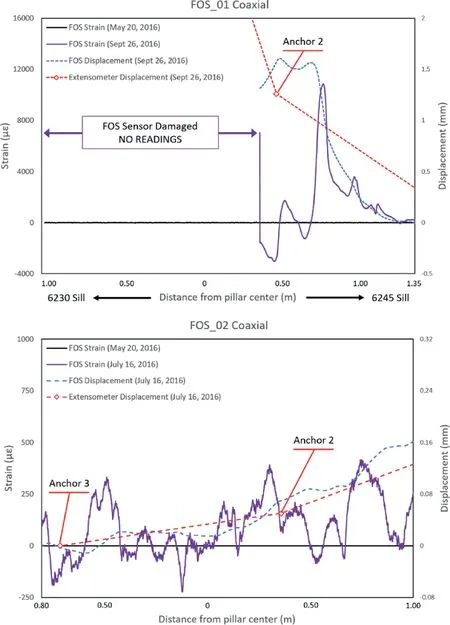
Fig.14. FOS strain and displacement profiles compared against interpolated extensometer displacement profiles for selected monitoring periods. The FOS displacement profiles have been obtained by integrating the given strain profile (from the 6245 sill for FOS_01 and from the toe of the sensor near the pillar core for FOS_02). For comparison with the extensometer displacement measurements,the measured anchor displacements have been averaged between extensometer EXTO_08 and EXTO_15(i.e.the immediately adjacent extensometers to the FOSs). Extensometer anchor displacements have been referenced to the first anchor position for FOS_01 and the third anchor position for FOS_02. Note:Negative strain is contractional and positive strain is extensile.
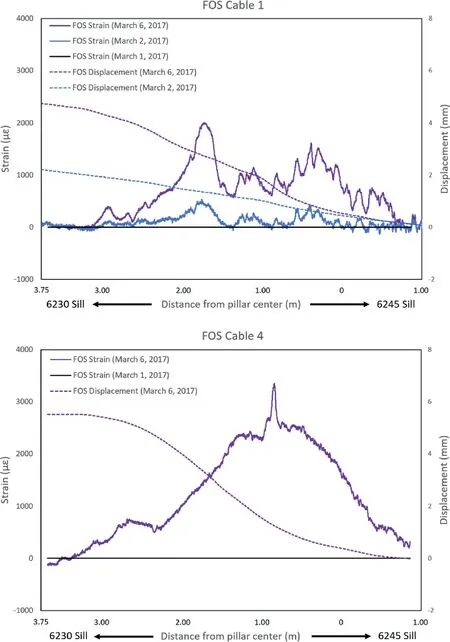
Fig.15. FOS cable strain profiles and their corresponding cable displacement profiles for the monitoring period of 1e6 March 2017. Negative strain is contractional and positive strain is extensile.
The strain (or load) mobilised along the cable is a result slip between the rock and cable. This generates shear stresses(traction) at the cable-to-grout interface. When observing the cable strain profiles, peaks correspond with localised dilational features across the pillar and decoupling between the cable and rock mass. Conversely, troughs indicate sections along the cable where a degree of compatibility with the rock mass has been maintained (refer to Fig. 16). Comparing the strain and displacement profiles from both cables, it is apparent that FOS Cable 1 has been subjected to a much less continuous load distribution, where numerous dilational and contractional locations are distinguishable, asserting that the displacement of the pillar sidewall is the result of numerous discrete rock block displacements internal to the pillar. In comparison, the strain profile of FOS Cable 4 is the result of a relatively distributed rock mass displacement profile.
Fig.17 presents the shear stressprofiles for FOS Cable 1 and FOS Cable 4 according to the following relationship based on elastic beam theory derived by Farmer (1975):

whererbis the radius of the cable;Ebis the Young’s modulus of the cable;and ε andxare the strain and position at the locationnalong the cable, respectively (the subscript, b, refers to the support element, the cable bolt). Referring the shear stress profile for FOS Cable 4, two distinct sections are discernable: (1) A pickup length(where the rock mass is slipping from the cable, resulting in a negative shear stress)and(2)An anchoring length(where the cable is slipping from the rock mass,resulting in a positive shear stress).In between these two sections is the neutral point, corresponding to the position of no relative displacement between the rock mass and cable and also the peak cable load (or strain). Referring to the shear stress profile for FOS Cable 1,the pickup length and anchoring length sections are only observable as relative regions, with no clear (or singular) neutral point location along the cable.
The two cable profiles denote the stark difference in the displacement response of the rock compositions each cable was installed into:the granitic footwall rocks(FOS Cable 1)and the PSZ(FOS Cable 4), as in agreement with displacement trends of the extensometers (Fig. 8). The relatively distributed load distribution of FOS Cable 4 suggests the PSZ is heavily damaged with no apparent rock blocks. Furthermore, this implies that shearing governs the yielding process across the PSZ span of the pillar.
4.3. BHPC results
The installation procedure for the BHPCs included installing and orientating the BHPC flatjack within a borehole, cement grouting the BHPC,and pressurising the BHPC to allow subsequent changes in the rock stress to be measured. According to Sellers (1970), the stress change measured by the BHPC within a relatively soft grout inclusion can be used to determine the stress change of a rock mass using the following relationship that provides an estimate of the stress reduction factor(SRF) within the hollow inclusion.

where

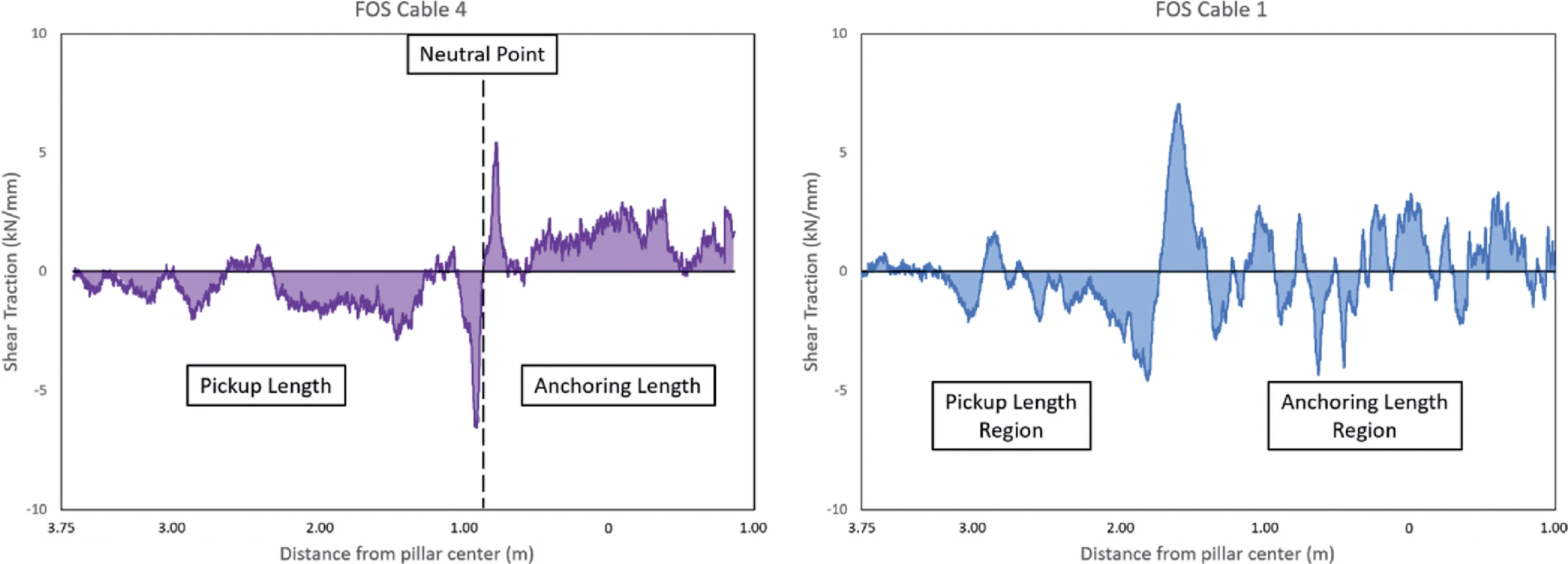
Fig.17. Shear traction (stress) profiles obtained from the 6 March 2017 measurements of the FOS cables. Negative tractions denote slip of the rock mass while positive tractions denote slip of the cable.
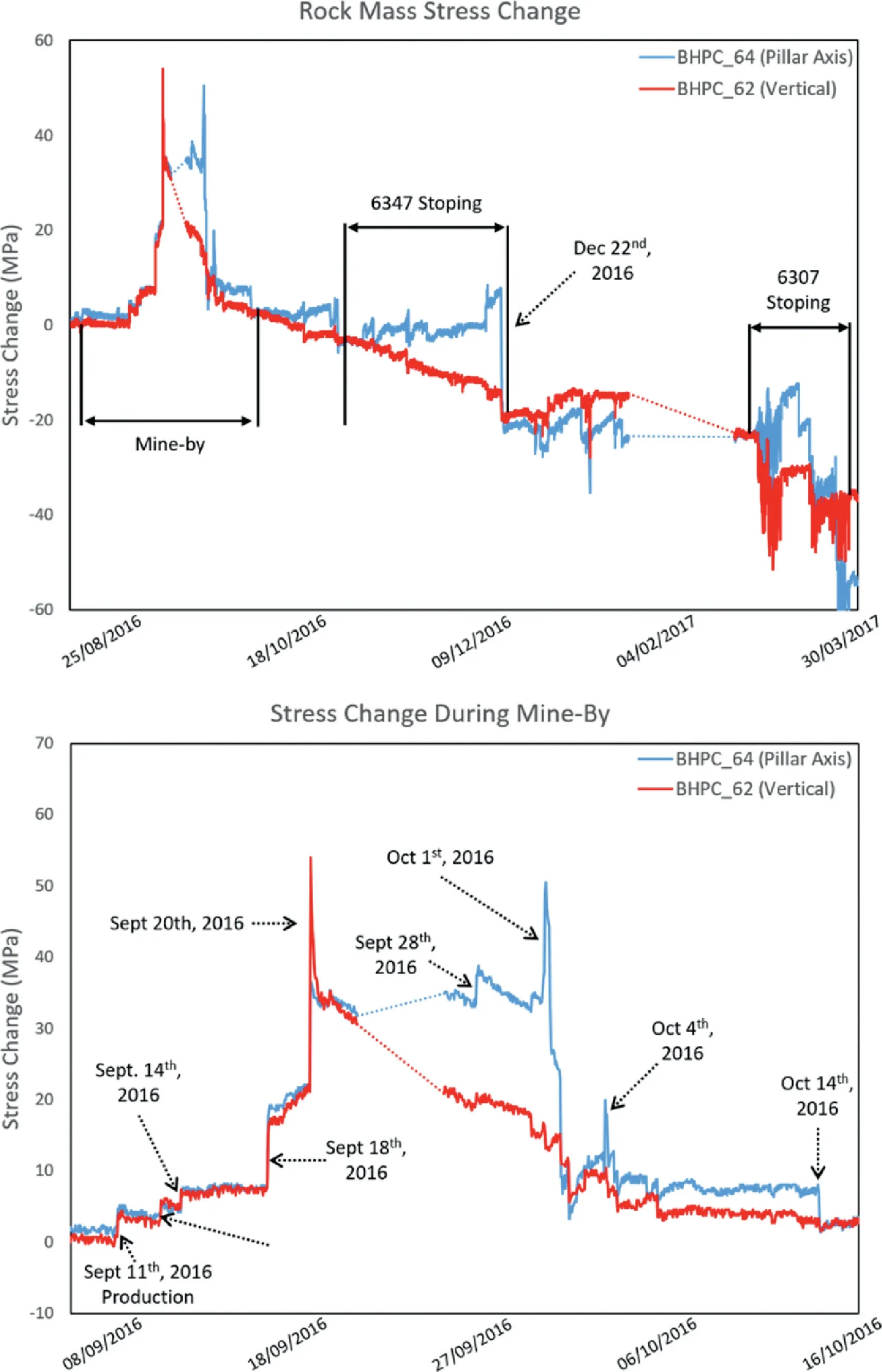
Fig. 18. Pressure-time series plots for BHPC_62 (aligned to measure vertical stress change within the pillar) and BHPC_64 (aligned to measures stress change along the pillar axis). Top: Rock mass stress change throughout the entire monitoring duration.Bottom: Rock mass stress change during the mine-by phase. Selected event dates are identified (refer to Table 2). A dashed line pressure profile indicates missing measurement data.

whereEis the Young’s modulus; y is the Poisson’s ratio; and the subscripts 1 and 2 refer to the rock mass and the grout,respectively.
Considering the previously listed properties for the footwall rocks and a 0.4 water/cement grout (Young’s modulus12 GPa,UCS60 MPa at full strength,Poisson’s ratio0.185,according to Hyett et al. (1992)), the BHPC stress change will represent approximately 32%of the rock mass stress change.Therefore,a prepressurisation level of 20 MPa for each BHPC was selected to accommodate approximately50 MPa of rock mass stress change.A factor in selecting this pressurisation level was the integrity of the cement grout(i.e.to not significantly damage the grout during prepressurisation).
The rock mass stress change for BHPC_64 and BHPC_62 measured over the entire monitoring period as well as during the mine-by period are presented in Fig. 18. The baseline reading for stress change was taken from 25 August 2016,corresponding to the stabilisation of the BHPCs post pre-pressurisation. There are three apparent regions of the pressure-time series plot:(1)The mine-by duration,(2)Mining of the 6347 stopes,and(3)Mining of the 6307 stopes. Similar to the extensometer data series, interpretation has primarily been constrained to the monitoring period before 22 December 2016,which coincides with the final mining operation of the 6347 stope.Following this event,the pressure in both BHPC_64 and BHPC_62 reached their minimum range (effectively no pressure remaining in the cell)and subsequent results fall outside of the sensors calibration. The results from BHPC_60 have not been presented in Fig. 18 as there were issues with pre-pressurising this instrument.
A strong relationship between the 6230 mine-by and stress change is evident for both BHPCs. Referring to the mine-by round locations shown in Fig. 2, the vertical stress (BHPC_62) rises with each mining activity and peaks with the advance on 20 September 2016.For 9 h following this advance,stress exponentially decreased a total of 20 MPa.Subsequently,vertical stress decreased linearly at a lower gradient. This date also corresponded with three mining induced seismic events being registered. The stress change along the pillar axis (BHPC_64) initially followed a similar trajectory as the vertical stress up to 20 September 2016.However,it is not until the 6230 advance on 1 October 2016 that a peak stress was reached(even though this BHPC is situated within the same advance position as BHPC_62),at which point stress decreased rapidly in a semilinear fashion. Both BHPCs experience a rapid loss of pressure following a peak measurement that was over 50 MPa. It is pragmatic to coincide this pressure decrease with damage to the grout(and surrounding rock mass). The immediately adjacent extensometer anchor locations to the BHPCs both measured rock mass strain in excess of 1% synchronous with the pressure decrease.Accordingly, the applicability of rock mass stress change in comparison to the original baseline on 25 August 2016 must be treated with speculation. However, it is compelling to observe that following the complete mining of the 6347 stope on 22 December 2016(and deconfinement at the ore end of the pillar)there was an immediate drop in the stress measured along the pillar’s axis(BHPC_64), which also coincided with twoMn2.0 events being measured.
5. Discussion
The original experiment outline sought to monitor the hard rock pillar response to 8010 level mining activities,primarily focusing on(1) the mine-by operation of the 6230 sill and (2) mining of the 6307 and 6308 stopes that were aligned with the pillar axis.However, prior to mining the 6307 or 6308 stope, many of the installed sensors had reached their sensing range. Accordingly,emphasis has been placed on examining the supported rock mass behaviour over the period of May 2016 to January 2017. Mining activities of significance during this monitoring period included:(1) mining of the 6327, 6328, and 6347 stopes, (2) mine-by of the 6230 sill, and (3) 0002 footwall development along the pillar of study (Table 2). These mining activities are used as the basis to further discuss the measured displacements across the pillar and to comment on the efficacy of ground control measures.
5.1. Rock mass displacements and the influence of the PSZ
The extensometer displacement-time series profiles (Fig. 8)detail a time-dependent nature to displacement stabilisation across the pillar following a mining activity. It is apparent that the extensometers within the vicinity of the PSZ(EXTO_08 and EXTO_09)measured larger magnitude displacements that also prolonged after mining activities.EXTO_08 and EXTO_09 measured over 60 mm of displacement at specific anchor locations(or positions within the pillar) by 10 October 2016. In comparison, the next closest measurement of displacement was made by EXTO_10, measuring 31.9 mm of displacement for anchor position 5. It is also apparent that displacement extended across the entire width of the pillar within the region of the PSZ. Fig. 19 displays selected strain rate contour profiles across the instrumented segment of the pillar.These profiles have been obtained by linearly contouring the strain measurements between all adjacent extensometer anchor locations along the pillar. The strain rate magnitudes correspond to the change in strain measured over the determined mining activity time duration (i.e. Fig. 10), unique for each extensometer anchor location. Two strain rate contour profiles are presented:
(1) 6 June 2016: Mining of the 6327 crown; and
(2) 20 September 2016: 6230 sill advance round.
These dates were selected as they depict the contrasting behaviour of the PSZ and the granitic footwall rocks before and after the 6230 sill was developed (August-to-October 2016).Accordingly,the extensometer measurements associated with the 6 June 2016 mining activity do not correspond to that of a sill drift pillar, but instead, a sidewall at the boundary of the level (which would have much more confinement than a pillar).Conversely,the measurements associated with the 20 September 2016 mining activity correspond to the pillar response (refer to Figs.1 and 2).
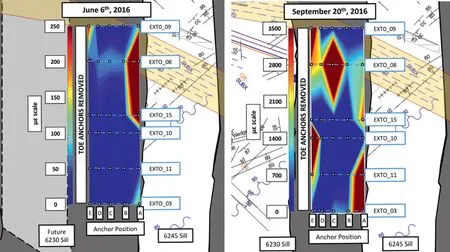
Fig.19. Microstrain (mε) contour profiles. Left: Strain induced from mining the 6327 crown on 6 June 2016. At this stage of mining, the 6230 sill was not developed. Right: Strain induced from the 6230 sill development round on 20 September 2016. This mine-by round corresponded with daylighting of the PSZ, situated near EXTO_08 and EXTO_09, as depicted in the geological overlay.Anchor position 6 measurements have been omitted from the strain contours due to missing data. Tensile strain is taken positive.Approximate distances of anchor positions from the 6245 sill: A - 1.09 m; B - 2.38 m; C - 3.52 m; D - 4.51 m; E 5.35 m.
Mining of the 6237 stope on 6 June 2016 induced the most measured strain of all the mining activities prior to the 6230 mine-by.At the head of the extensometers,along the 6245 sill wall,more strain was measured within the vicinity of the mapped shear, but the most significant contrast between the shear zone and the footwall rocks is evident towards the toe-end of the extensometers(Anchor position E,approximately 5 m from the 6245 sill sidewall).Only EXTO_09 measured significant strain. In addition, only EXTO_08 and EXTO_09 measured strain at the middle span of the pillar.Referring to Fig.1,this indicates,at minimum,a mining level connectivity of the PSZ, as the 6327 stope is aligned with the eastern-adjacent 6270 sill.This substantiates previous findings that detail the PSZ to heavily influence the distribution of stress across the mining level(Malek et al.,2008;Snelling et al.,2013;Morissette et al., 2017a).
The 6230 development round taken on 20 September 2016 coincided with daylighting of the PSZ across the instrumented pillar.In this instance,it is observed that the contour profile agrees well with the geological section in defining the extent of the PSZ,although the relatively large distance between EXTO_08 and EXTO_15 does exaggerate the strain between anchor locations of the two extensometers.There is a significant contrast between the pillar’s strain response in the vicinity of the PSZ and of the footwall rocks(i.e.towards the nose of the pillar).Large rock mass strains are evident along a majority of the pillar sidewalls;however,it is only in the vicinity of the PSZ that strain extends across the entirety of the pillar. Although the PSZ has been reported as healed(Coulson,1997), the selected strain contours and the displacement trends of EXTO_08 and EXTO_09 indicate that the PSZ is highly active during mining development and production. The lack of seismicity registered for the large displacements of the PSZ also suggests that this rock mass unit within the pillar is at a residual state (acting aseismically). This corroborates observations from the FOS cable bolts, which indicated that the PSZ is heavily damaged and that shear governs its yield behaviour,while the granitic footwall rocks displayed a fracture driven failure process. This can be further extended to indicate that the time-dependent nature of the PSZ is similar to that which is often considered creep,being a shear strain or distortion process. Contrarily, the footwall rocks experience stress relaxation through tensile crack initiation, propagation, and accumulation (Diederichs,1999; Paraskevopoulou, 2016).
The stiffness transition between the PSZ and the granitic footwall rocks is of significance to safety. As discussed by Diederichs(2018), with excavation advance through a heterogenous rock mass with contrasting stiffness,energy will initially be stored in the softer unit(in this study,the PSZ).As critical stress is reached in the softer unit,it is then transferred to the stiffer unit(the metavolcanic footwall rocks).Conceptually,this will result in increased tangential stresses within proximity of the material transition zone and,consequently, increased rockburst susceptibility at and near the excavation face when passing through this zone. Referring to Table 2, three mining induced seismic events with a peak magnitude of 1.2 corresponded with the sill advance round transecting the PSZ on 20 September 2016 (the largest magnitude registered during the 6230 mine-by). This aligns with previous findings that the vast majority of rockburst in Creighton Deep occur within the vicinity of mine-scale shear zones(Morissette et al.,2017a),but not necessarily as a result of slip (Snelling et al., 2013).
It is important to acknowledge that the displacement measurements correspond to the supported rock mass,and that ground support has a substantial role in stabilising crack growth following a mining activity. Without support, it can be expected that geometric correction in the form of the spalling and crack propagation would undoubtedly result in excessive tangential stresses near the excavation periphery and induce a propagation of instability towards the core of the pillar in the form of slabbing and potentially strain bursting of thicker slabs (Martin and Christiansson, 2009;Diederichs and Martin, 2010). Therefore, in highly stressed hard rock conditions, similar to those experienced at Creighton mine,there is a great benefit to maintaining the baggage zone of yielded rock in proximity of the excavation periphery such that a feedback pressure (i.e. confinement) can be generated and progressive damage can be choked off (Diederichs et al., 2004; Diederichs,2007; Walton et al., 2016). In this regard, scaling should only be performed following initial excavation or if further damage necessitates. Rehabilitation reinforcement methods should be favoured, recognizing that the role of ground support in such mining situations is not to entirely restrict periphery displacements or the geometry of the excavation.
Assessing the timing and extent of the required reinforcement requires a strong understanding of constituent support element loadedisplacement behaviour, which can certainly be achieved using instrumented support elements. However, it is possible to estimate that state of an existing support system with excavation displacement information, as discussed in the following section.
5.2. Stability of the supported rock mass
An understanding of an excavation’s vulnerability to rockbursting is a critical aspect to safety and performance in seismically active mines. There are several empirical and semi-analytical rockburst risk assessment systems (e.g. Kaiser et al., 1996;Albrecht and Potvin, 2005; Heal et al., 2006; Heal, 2010) taking several indexed factors into consideration,such as rock mass stress,excavation geometry, rock mass structure/features, and ground support effectiveness. It is recommended to reassess indexed factors after notable seismic events are experienced. However, the ground support factor, or the remaining capacity of the support system,is often overlooked until a degree of failure is observed.In view of the rock mass displacements measured at Creighton mine,it is argued that the initial support indexed factor determined after installing the ground support system (during drift development)would drastically underestimate the remaining capacity of the support system at a later stage (e.g. during major stoping operations). It is proposed that evolving state of the support system is perhaps the most salient factor to be quantified on a daily (or continuous)basis.A seismically prone excavation is not necessarily a rockburst prone excavation if the support system maintains sufficient residual capacity following a seismic or displacement inducing event. Kaiser et al. (1996) discussed that the loade displacement characteristics of a support system’s constituent support elements can be used to assess support consumption, or remaining support capacity.This concept is demonstrated using the extensometer displacement data from the pillar study and characteristic loadedisplacement profiles for three selected support tendons.
Fig.20 displays common coaxial loadedisplacement profiles for 20 mm cement grouted rebar,46 mm friction set,and 22 mm resin grouted D-bolt from various laboratory tests (Blanco Martín et al.,2011; Li, 2012, 2017; Vlachopoulos et al., 2018). The corresponding load and elongation safety margins (SM) that have been determined according to Eq. (7) are also presented as

whereFSis the factor of safety for load or elongation calculated using the peak load and corresponding elongation (except for the coaxially loaded friction set for which a maximum elongation of 200 mm (Kaiser et al.,1996) was selected). The SM profiles represent the static capacities of the support members. As noted by Potvin and Wesseloo(2013),it is difficult to ascertain the dynamic capacity of an entire support system; however, an estimate of the available energy absorption of an individual support member can be obtained by determining the potential work from the loade displacement profiles (i.e. the area under the loadedisplacement profile).
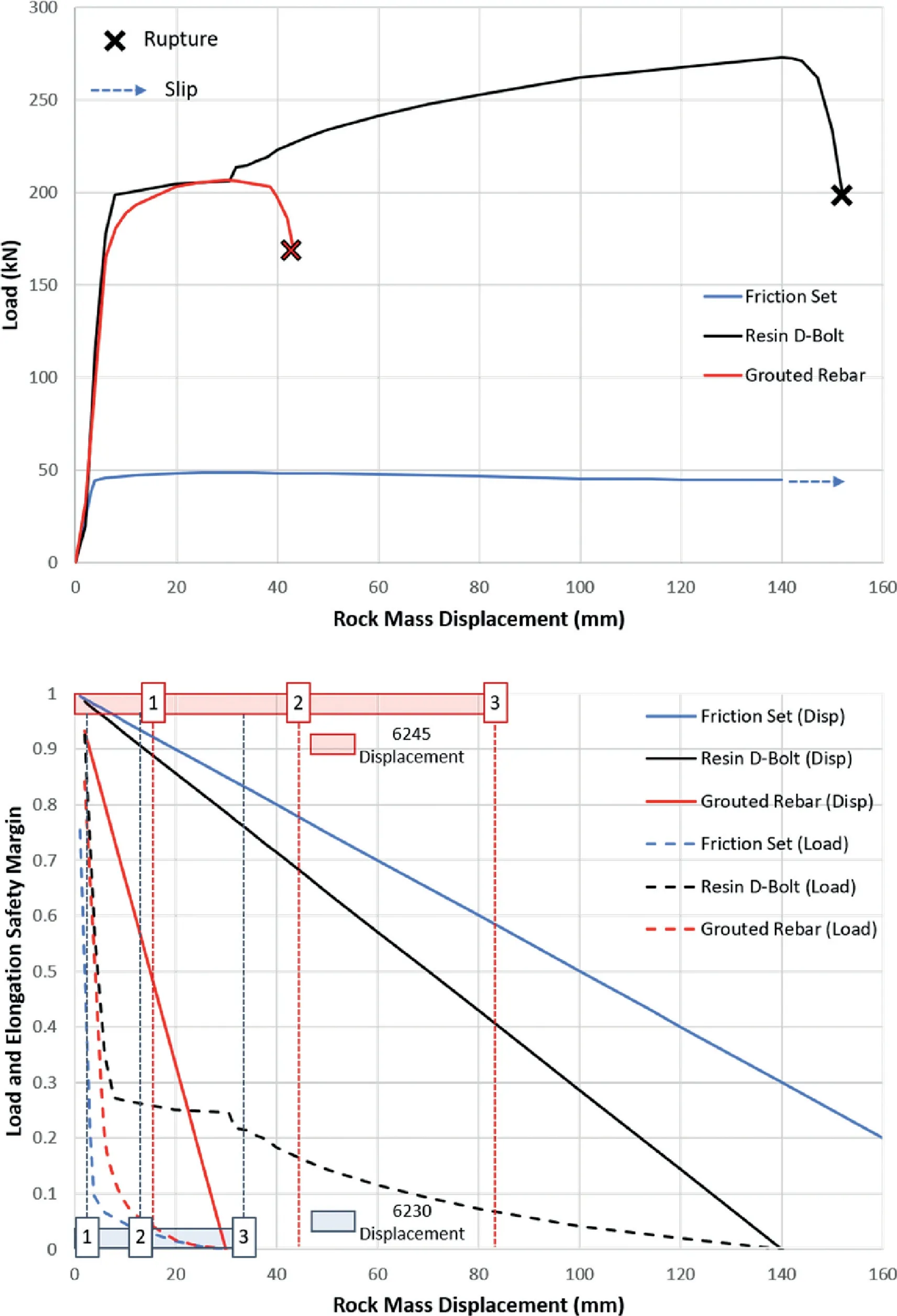
Fig. 20. Load-displacement profiles (from Blanco Martín et al., 2011; Li, 2012, 2017;Vlachopoulos et al., 2018) (top) and corresponding SM profiles (bottom) for three support element types: 20 mm cement grouted rebar, 46 mm friction set,and 22 mm resin grouted D-bolt. In the SM plots, the solid line corresponds to the elongation SM per excavation displacement and the dashed line corresponds to the load SM per excavation displacement. A depiction of the support element elongation and load consumption is shown using measured displacements of the 6230 and 6245 sidewalls from EXTO_11 (as per Table 5). The three selected dates coincide with: (1) 11 September 2016dInstallation of support from the 6230 sill, near-parallel with the selected extensometer, (2) 6 November 2016dCompletion of the 6230 sill, and (3) 22 December 2016dFinal production blast of the 6347 stope.
As an example of how the measured rock mass displacements can be used to assess the state of a support system, the displacements measured by EXTO_11 have been examined along both the 6230 sill and 6245 sill for three selected dates(Table 5).The listed displacement values for the 6230 and 6245 pillar sidewalls correspond to the maximum displacement measured by anchor 5 or anchor 6 and the head anchor or anchor 1,respectively(i.e.anchor locations within a typical bolting horizon and near the excavation periphery).To provide a better estimate of the displacement of the 6245 sidewall,it is assumed that the 6245 sill experienced a similar displacement history as that measured for the 6230 during mine-by(at minimum). Therefore, the displacement listed for the 6245 sidewall is taken as the sum of the displacement experienced by the 6230 sidewall post mine-by(6 November 2016)and the given 6245sidewall measurement.Assuming that the measured displacement(which is coaxial to the pillar’s core) is approximately the displacement experienced by individual support tendons, the displacement values listed in Table 5 can be used to quantify the static load and elongation SM as shown in Fig. 20 (bottom).

Table 56230 and 6245 sidewall displacement measurements from extensometer EXTO_11 at selected measurement dates. 11 September 2016 is referenced as the installation date for the support system aligned with EXTO_11. 6 November 2016 corresponds to the completion of the 6230 sill. 22 December 2016 corresponds to the final mining operation of the 6347 stope.For simplicity,it has been assumed that all support typologies have been pretensioned to 50 kN or approximately 2.5 mm of elongation.
As the pillar sidewalls displace,the load and elongation capacity of the given support member is consumed in manner that is dependent on the specific loadedisplacement characteristics. For example, if a grouter rebar member was to have been installed in either the 6230 or 6245 sidewall, there would be no remaining support capacity in either sidewall (i.e. failure of the support member) by the end of the 6230 sill development (6 November 2016)indicated in Fig.20.In comparison,the D-bolt and friction set members (which were the support elements used on the 8010 level)would both have remaining capacity for managing static and dynamic loads. This endorses the decision at Creighton mine to move away from stiff support tendons such as grouted rebar in such high stress and high bulking developments.This assessment of the support member’s residual static capacity using displacement measurements can be used to aid in the selection/timing of resupport measures. In addition, a similar procedure that considers the remaining energy absorption SM with empirical energy demanded charts (e.g. Diederichs, 2018) would allow for a prediction of the potential rockburst magnitude that can be withstood.However,this analysis does require displacement measurement to align with the axis of the support element.Surveyed displacements of the excavation periphery could be used to assess support installed in the shoulders and back, but internal rock mass displacements(such as those provided by the extensometers and FOSs in this study)are crucial to evaluating performance along a support element’s length.
It is important to recognise the role of non-coaxial displacements and surface support in dictating the ultimate capacity of the support system.Previous studies(Heal,2010;Potvin and Wesseloo,2013) have found the dynamic capacity of a support system to be less than that of the composite support members and that instead it is controlled by the weakest link,often the shotcrete or mesh at the excavation periphery. Non-coaxial displacements will also be anticipated to significantly reduce the elongation capacity of a support element in the form of lock-up (Groccia et al., 2016), preventing the full member length from being mobilised.Nonetheless,it is apparent that the pillar displacements measured at Creighton mine necessitate high load and elongation capacity support members (e.g. D-bolts and friction sets). As demonstrated, the capacity of stiff support members (e.g. grouted rebar) would quickly be expended and would increase the potential risk to a rockburst by building stress at the excavation periphery and releasing energy in a brittle manner. In contrast, high static elongation support elements enable excavation strategies that allow for increased levels of controlled excavation deformations reducing the dynamic demand (i.e. allow the rock mass to fracture and bulk to a certain degree). This is corroborated by a general trend of decreased excavation damage per rockburst in recent years at Creighton mine(since moving away from stiff support such as grouted rebar)even though the mine has progressed deeper (Morissette et al., 2017b).An observation in the displacement data that confirms this concept is the general progressive deformation trend measured along both the 6230 and 6245 sidewalls, even though the 6230 sill was not subjected to wall precondition.
5.3. Comments on seismicity
Over the course of the monitoring campaign, there were no significant displacement events(i.e.above discernable background noise)that did not correlate directly with a mining activity.This is primarily attributed to the locality of the instrumentation,which is restricted to approximately 15.25 m of one pillar on the 8010 production level.In comparison,the mine’s seismic array spans across many levels within the mine.For this reason,an extensive analysis was not conducted between the mine wide spatial distribution of seismicity and measured displacements.However,it is worthwhile to mention that the displacement-time trends per mining activity are very similar in profile to regular temporal seismic response profiles (Vallejos and McKinnon, 2011; Woodward et al., 2017),which often monitor seismic events lower thanMn2.In a recent seismicity study at Creighton mine, seismic decay time was found to exceed 8 h in only 10% of cases (Vallejos and McKinnon, 2011).Referring to Fig. 11, a similar trend for the time-duration of displacements was determined. In this regard, the measured displacements of the pillar are predominantly associatedMn< 0 events, which often comprise over 99% of mine seismicity and are well correlated in time and space with mining activities (Hudyma et al., 2017).
6. Summary
An array of six multi-point rod extensometers, six FOSs, and three BHPCs were installed across a 15.24 m lengthwise segment of a hard rock sill drift pillar at a depth of 2.44 km in Creighton mine.Throughout an approximately ten-month long monitoring duration,from May 2016 to March 2017,the pillar’s displacement,strain,and pressure responses were measured,specifically focusing on the induced rock mass response to 8010 level mining activities,including:(1)mine-by of the pillar,(2)footwall development along a segment of the instrumented pillar, and (3) stoping operations aligned with, and adjacent to, the pillar’s axis. Due to the high in situ stress ratio, large displacements in the form of bulking at the pillar sidewalls were anticipated and the relatively massive granitic-gabbro host rock was expected to deform in a brittle failure process. The variety of sensing technologies installed across the span of the pillar allowed for this anticipated behaviour to be measured,allowing dilation at the microstrain level to be visualised and differentiated from large rock mass dilation/bulking at the centimetre scale.
The extensometers provided excellent temporal resolution for rock mass displacement measurements throughout the monitoring campaign (1-h logging interval over 10 months). Using these measurements, a process was developed to identify the timeduration of displacements induced from mining activities (analogous to seismic decay time) by analysing velocity-time series profiles. This process indicated that for 83.7% of the cases where displacement was induced at an extensometer anchor position,the magnitude was less than 1 mm(and 62.1%instances were less than 0.1 mm).The process also indicated a time-dependent nature to the rock mass displacements. Over half of the induced displacements were found to prolong for more than 1 h. In general, larger magnitude displacements and longer displacement time-durations were measured at the pillar’s sidewalls than at the core. An exception was measured in the vicinity of the PSZ,a several metrethick fractured zone of steeply dipping schistosity extended across a segment of the pillar.Through the PSZ,the largest displacements were measured (over 80 mm cumulative), the longest time durations were determined (57 h), and displacement was measured through the core of the pillar. A linearly contoured strain plot between all measurement positions of the six extensometers provided a very useful depiction of the PSZ, defining its extent as per the geological section.
In comparison with the extensometer measurements, the FOSs provided superior spatial resolution, detailing substantially more insight into the displacement response across the pillar.Within the granitic-gabbro footwall rocks, highly localised, brittle behaviour was captured. Contrarily, within the PSZ, shear dominated behaviour was observed. This indicated that the highly time-dependent nature of the PSZ is akin to a shear strain or distortion process while the footwall rocks are associated with a fracture driven process. The strong agreement between the displacement magnitude measured with the extensometers and the FOSs(especially at the submillimetre scale) highlights the vast potential for further use and development of the FOS technique to measure localised brittle rock mass behaviour and define regions of contrasting damage zones (e.g. the footwall rocks in comparison to the PSZ).There is also significant benefit to be gained from continued use of DOS with ground support members, such as the cable bolts instrumented in this experiment, as the entire load distribution across the support member is measured.This provides an improved understanding of the support member’s loadedisplacement characteristics and could be used to augment support system assessment procedures, such as the SM assessment demonstrated for grouted rebar, friction sets, and D-bolts.
The use of support members with combined high load and static elongation capacities (e.g. the D-bolt) greatly contributed to excavation stability and mitigation of rockbursts on the mining level.The continual measurement of displacements at the sidewalls of the pillar demonstrated the capability of the support system to allow the rock mass to bulk and dissipate stress through controlled excavation displacements, while maintaining excavation integrity.Although the pillar sidewall of the 6230 sill was not subjected to preconditioning, it is apparent that the support system did accommodate stress relief and baggage zone development. However, the seismicity and large displacements measured after daylighting the PSZ indicates that an agile excavation approach is required when crossing transition zones of contrasting material stiffness in highly stressed rock, even when using a rockburst compatible support system.
Declaration of Competing Interest
The authors wish to confirm that there are no known conflicts of interest associated with this publication and there has been no significant financial support for this work that could have influenced its outcome.
Acknowledgments
The authors wish to thank Vale’s Ontario Operations for permission to compile this paper as well as the Ground Control staff at Creighton mine for their operational input and collaboration throughout the monitoring duration.Funding for this research was supported by Mitacs through the Mitacs Accelerate Program, the Natural Sciences and Engineering Research Council of Canada(NSERC),and the RMC Green Team.Digital instrumentation used in this project was donated by YieldPoint Inc.
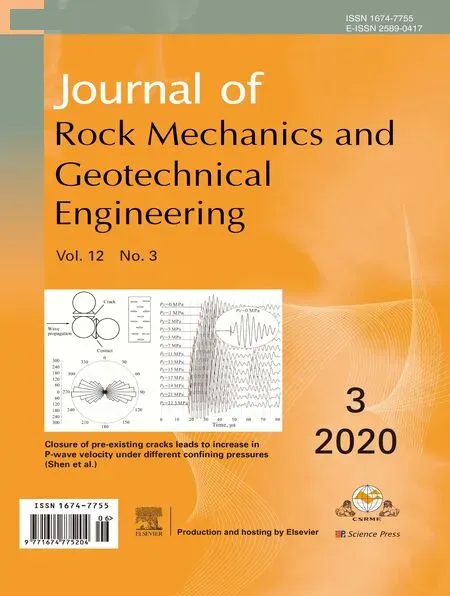 Journal of Rock Mechanics and Geotechnical Engineering2020年3期
Journal of Rock Mechanics and Geotechnical Engineering2020年3期
- Journal of Rock Mechanics and Geotechnical Engineering的其它文章
- Influence of location of large-scale asperity on shear strength of concrete-rock interface under eccentric load
- Controlling effects of differential swelling index on evolution of coal permeability
- Factor of safety of strain-softening slopes
- Modeling behaviors of a coal pillar rib using the progressive S-shaped yield criterion
- A method to model the effect of pre-existing cracks on P-wave velocity in rocks
- Polyaxial strength criterion and closed-form solution for squeezing rock conditions
